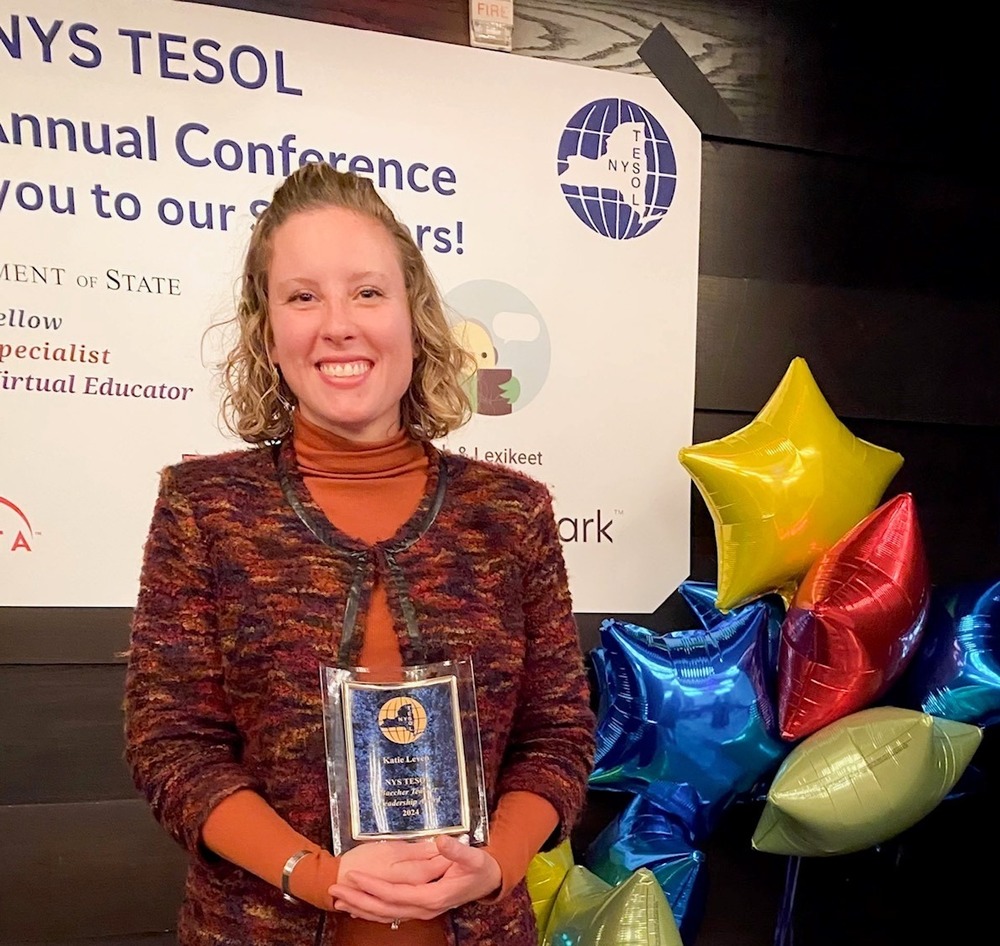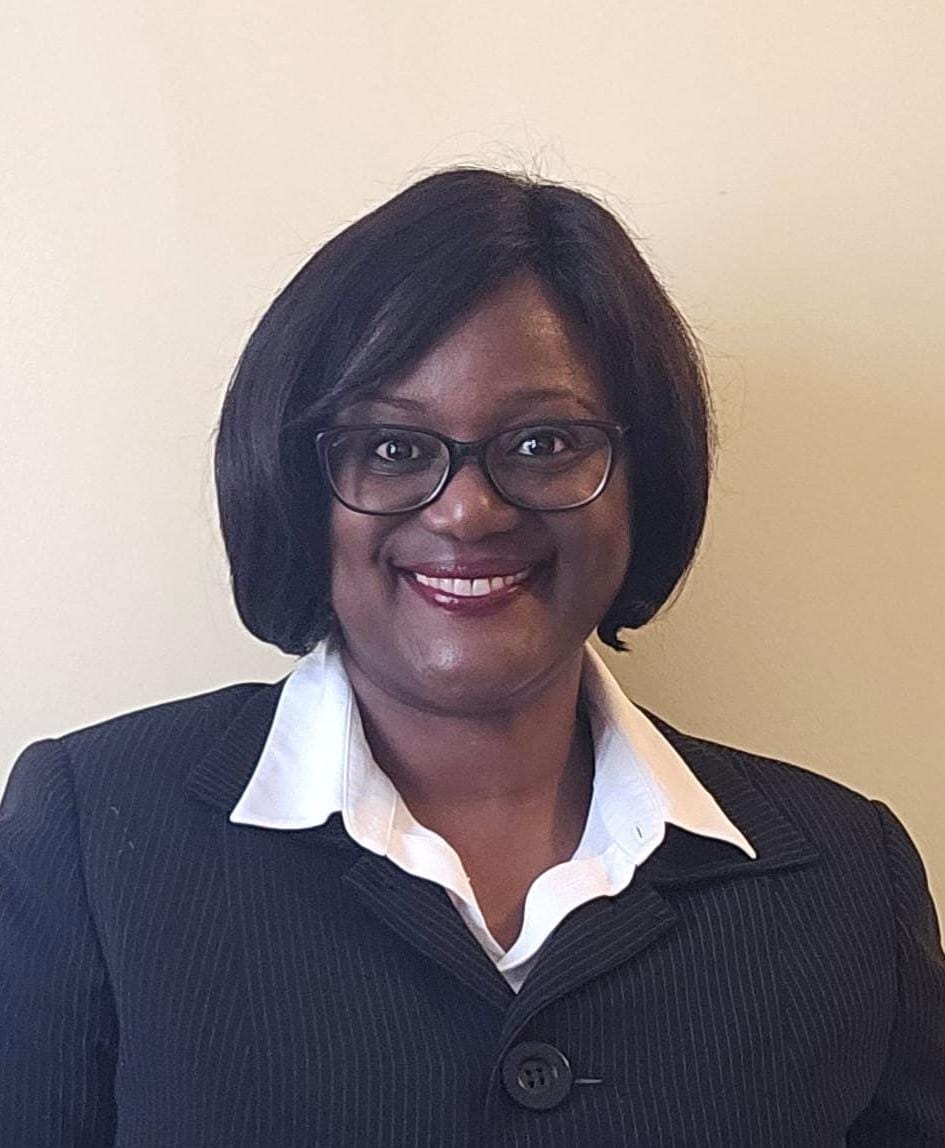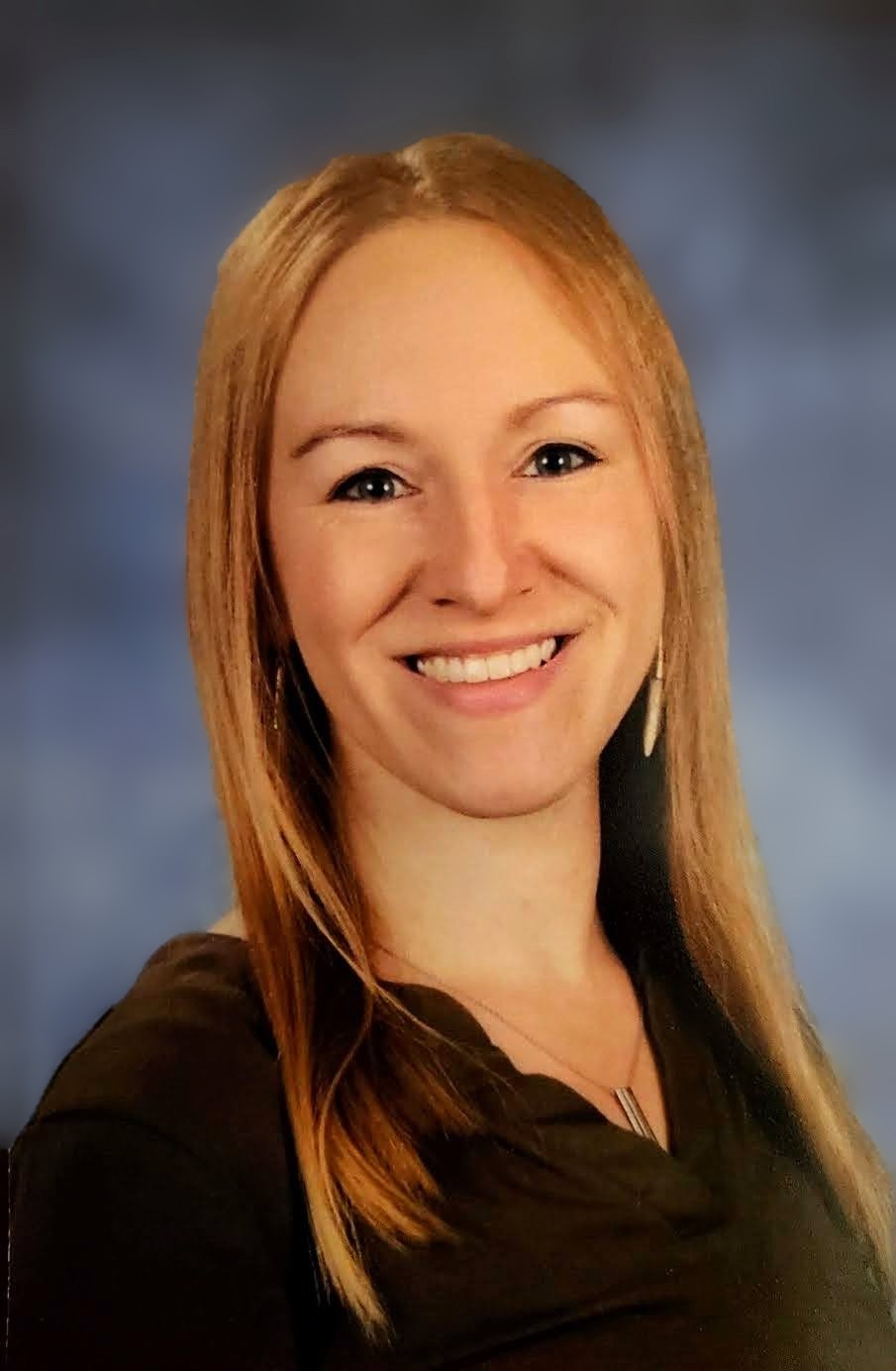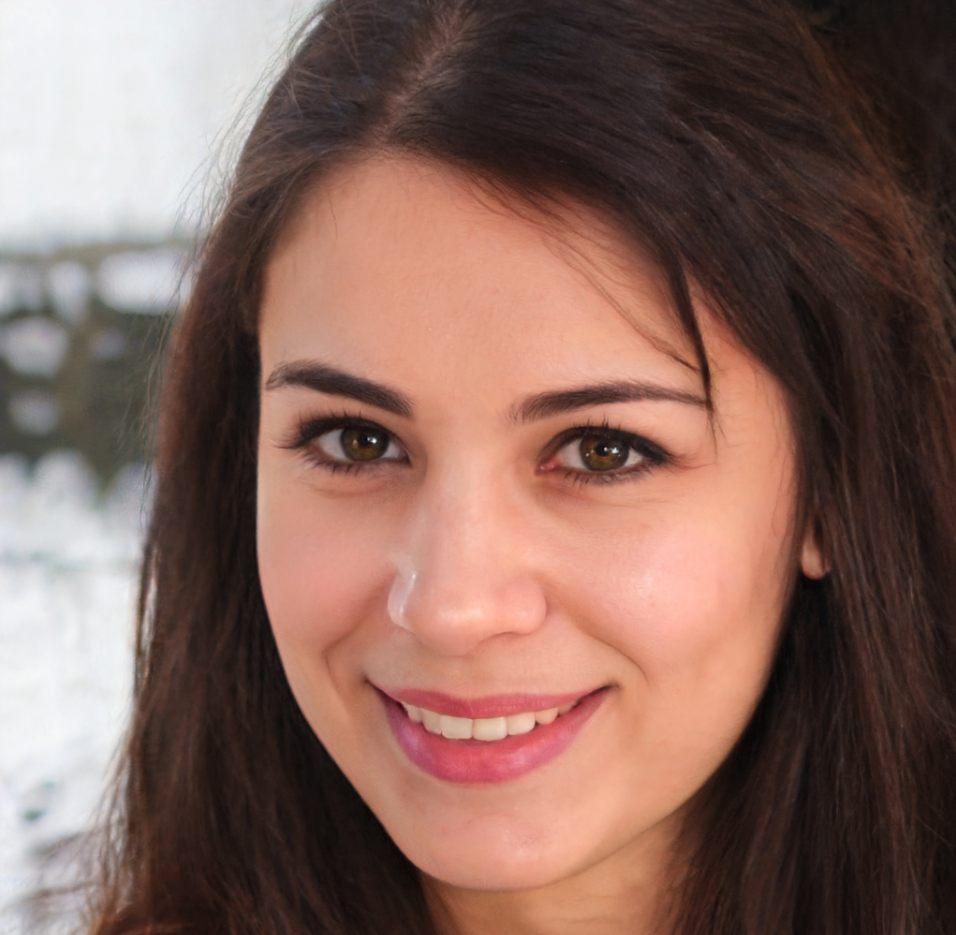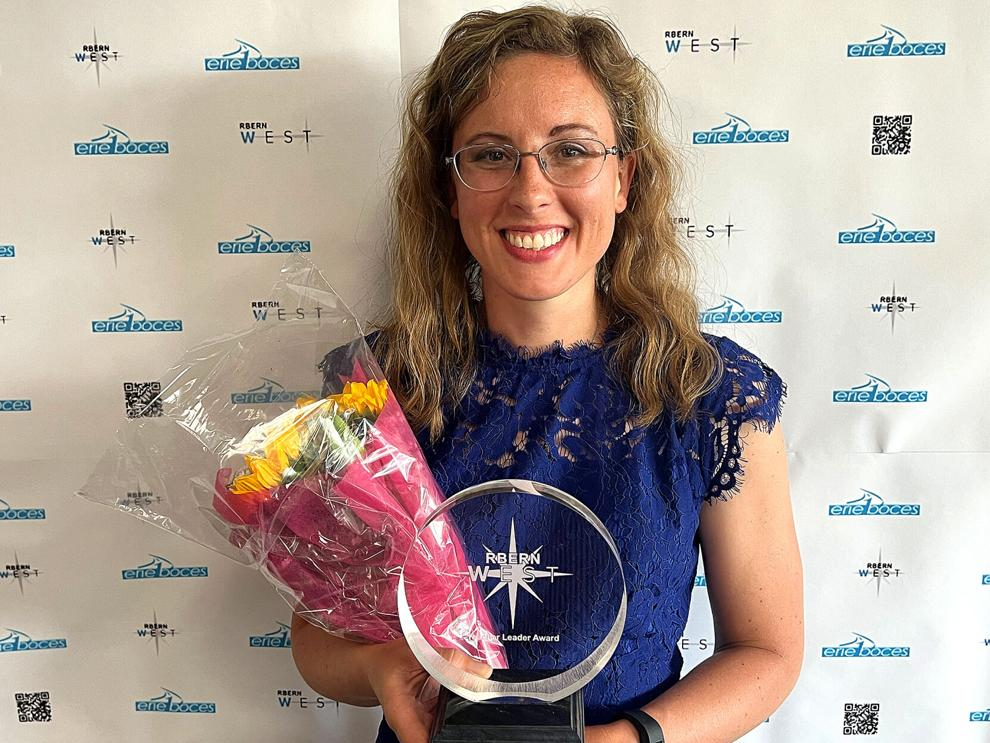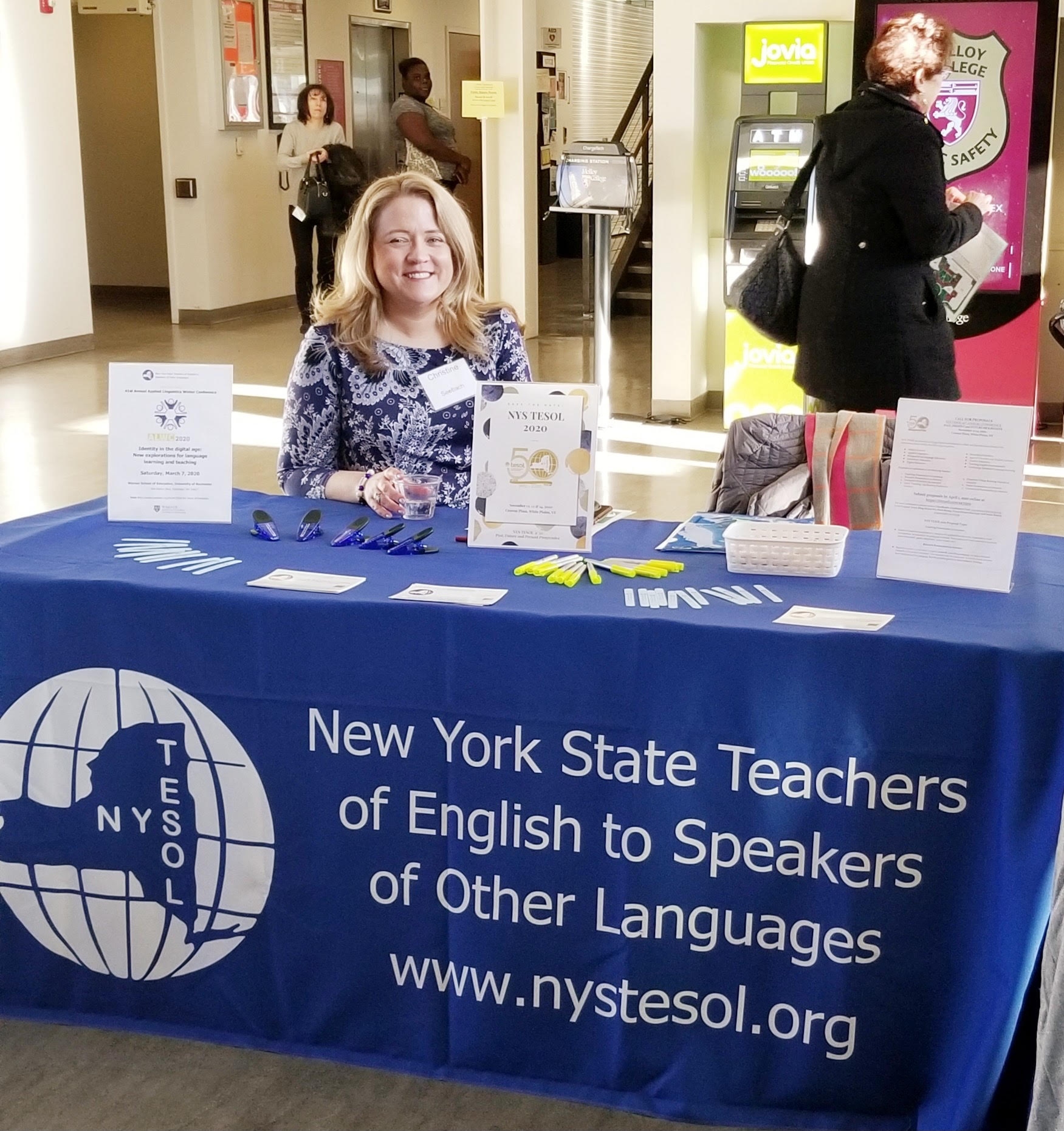NYS TESOL Blog
Back to BlogsNYS TESOL BLOG
Do you want to share your thoughts, strategies, and practices from the world of TESOL in a more informal way? Contribute to our NYS TESOL blog where you can write about your views, teaching tips, and resources.
Our blog explores emergent trends and current issues. We are making it more inclusive by inviting you to post comments and share your thoughts with us. Our blog strives to be multimodal, including cartoons, infographics, videos, you name it! If you are interested in contributing to our blog, email vpcommunications@nystesol.org.
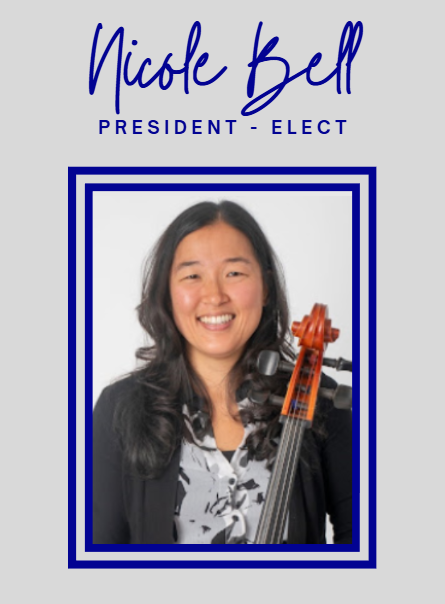
Get to know NYS TESOL’s 2026 President-Elect, Nikki Bell! In this interview, Nikki opens up about her professional journey, her passion for collaboration, and her goals for supporting educators and multilingual learners across New York State. Whether you're a longtime member or newly joining us, this conversation offers a meaningful look at the purpose and heart behind her leadership.
Author: Katie Leven
NYS TESOL, VP of Communications
ENL Teacher, Orleans/Niagara BOCES
Editorial written by: Katie Leven, Vice President of Communications
During the summer of 2024, the NYS TESOL Executive Board solicited nominations to fill vacancies on the Executive Board. From the nominations received, the Board approved the slate of nominees. Please note that biographical information about each candidate is available below.
On behalf of the Executive Board, we appreciate your input into the election process of NYS TESOL and your contribution as a member of NYS TESOL. If you have any questions, please get in touch with me at pres-elect@nystesol.org.
Voting starts October 1st and ends October 15, 2025.
Author: Nadger S. Henry, Ed.D.
Professional Affiliation: New York City Public Schools (NYCPS) -
Assistant Principal; Alumni, Johns Hopkins University School of Education
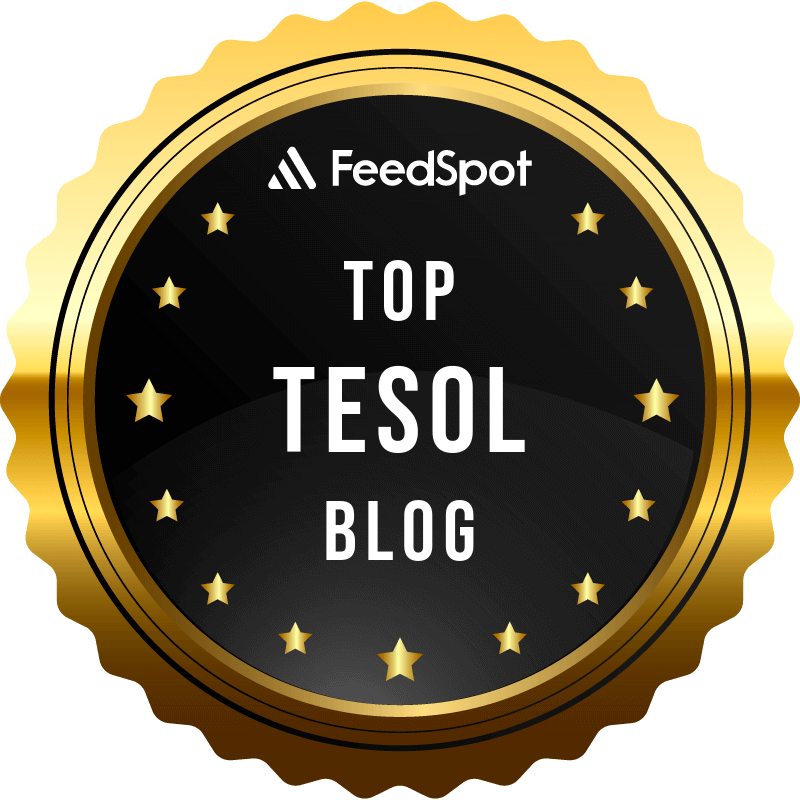
We are thrilled to share some exciting news with our community: the NYS TESOL Blog has been recognized by Feedspot as one of the Top 25 TESOL Blogs on the Web!
by: Katie Leven
by: Kelly Aldinger
For educators and administrators alike, professional learning that’s meaningful, sustainable, and flexible is more essential—and more elusive—than ever. Teachers are navigating the shifting demands of instruction, administrators are responding to evolving policy and accountability frameworks, and higher education professionals are preparing future educators for culturally and linguistically diverse classrooms. How can we create PD that meets everyone where they are?
Enter the Book Relay—a collaborative model that blends the reflective depth of professional reading with the practical ease of asynchronous participation. Whether you're a K–12 teacher, instructional coach, administrator, or higher ed faculty member, this approach has something for you.
by: Dr. Dilini Toussaint

Collaboration between English as a New Language (ENL) teachers and literacy coaches is essential in fostering language development and academic success for multilingual learners. In today’s diverse classrooms, multilingual learners bring unique strengths and needs that require intentional, research-based instructional practices. By leveraging each other’s expertise, ENL teachers and literacy coaches can create meaningful learning experiences that support all students.
by: Katie Leven
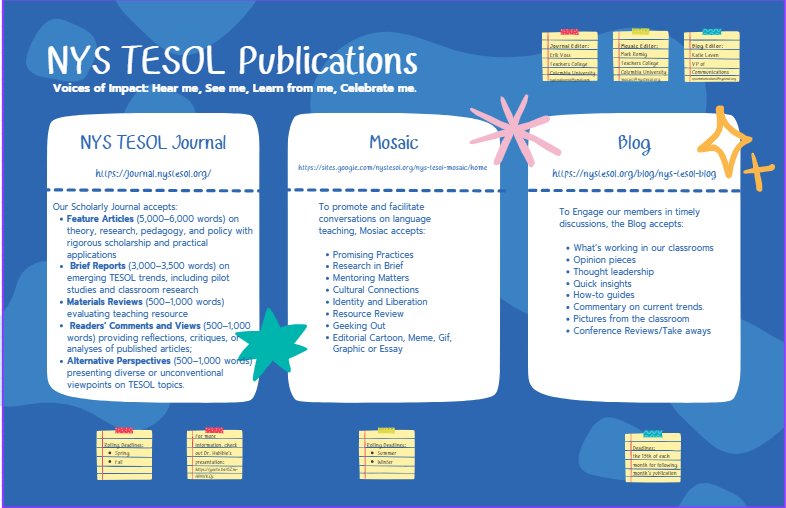
Welcome from the 2025 President and Executive Board!
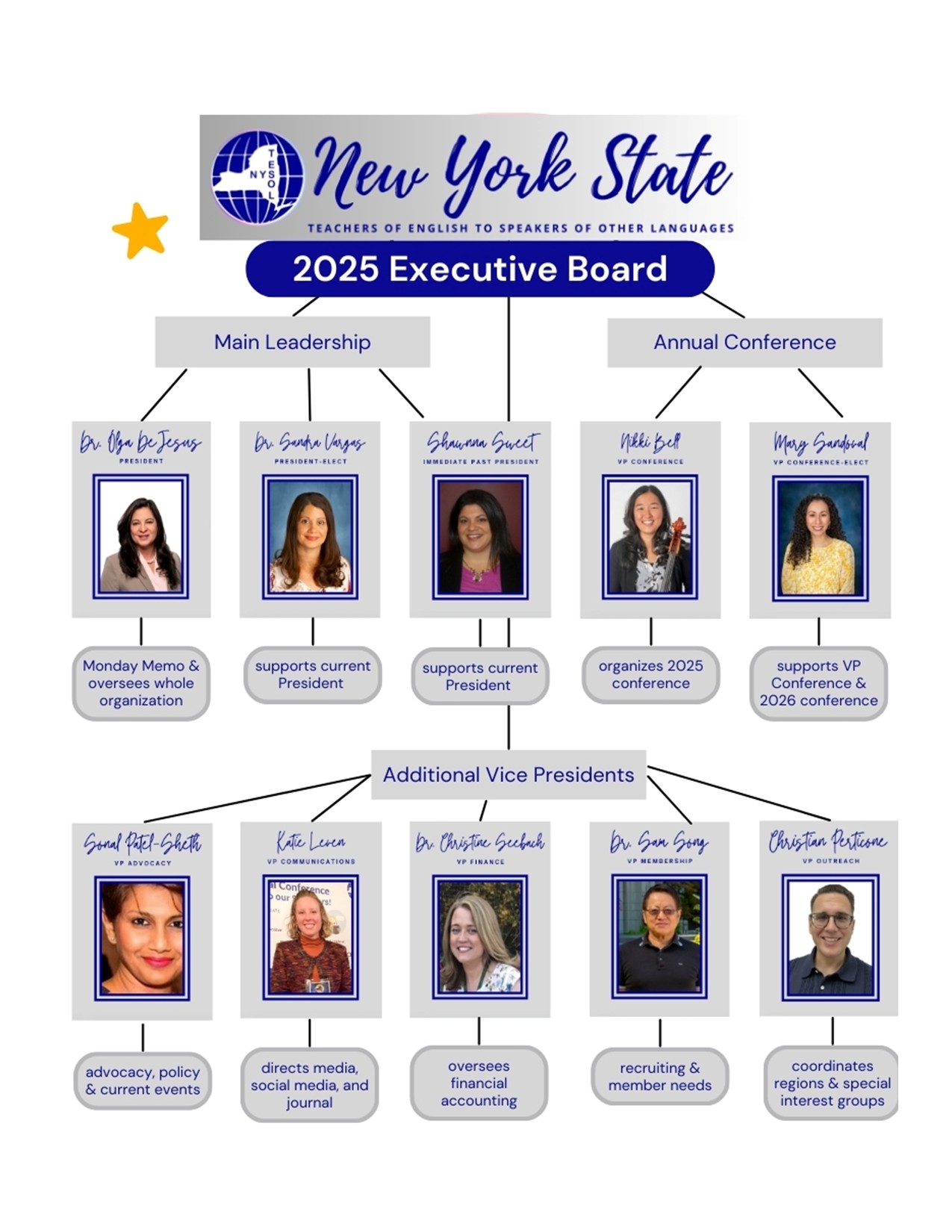
The 54th NYS TESOL Annual Conference 2024
Featured Speaker on November 16th, 2024 1:00PM
The 54th NYS TESOL Annual Conference 2024
Featured Speaker on November 16th, 2024 from 11:15-12:00PM
Dr. Justin Gerald
The 54th NYS TESOL Annual Conference 2024
Featured Speaker on November 16th, 2024 from 9:15am-9:55am
Dr. Pejman Habibie
The 54th NYS TESOL Annual Conference 2024
Panel Discussion on November 15th from 11:15am to 12:00PM
Dr. Maite T. Sánchez
The 54th NYS TESOL Annual Conference 2024
Panel Discussion on November 15th from 11:15am to 12:00PM
Mr. Ron Woo
The 54th NYS TESOL Annual Conference 2024
Panel Discussion on November 15th from 11:15am to 12:00PM
Dr. Diane M. Wynne
Featured Speaker on November 15th, 2024, 9:15am-10:00am
The 54th NYS TESOL Annual Conference 2024
Dr. Lillian Ardell – In-Person Day, Nov. 15, Keynote Speaker, 9:15 to 10:00 AM
Featured Speaker on October 19, 2024 from 2:15PM to 3:00PM
The 54th NYS TESOL Annual Conference 2024
Dr. Andrea Honigsfeld
Featured Speaker on October 19, 2024
The 54th NYS TESOL Annual Conference 2024
Dr. Fernanda Liberali (PUC-SP/ CNPq)
Dr. Jasmin Cowin
Featured Speaker on October 19, 2024
The 54th NYS TESOL Annual Conference 2024
Description:
Prof. Cowin’s address invites K-12 TESOL educators to investigate the significance of situational awareness in contemporary language teaching. The concept of situational awareness will be dissected, underscoring its role in enabling TESOL educators to perceive, interpret, and respond effectively to the dynamic interplay between multilingual student needs, exponential technologies, and evolving pedagogical practices.
The plenary will analyze practical strategies for integrating recent pedagogical research and technology adoption in language teaching and learning. Examples of these strategies include adaptive lesson planning, leveraging technology for individualized instruction, and fostering a culturally responsive classroom environment. Additionally, this session will examine the dual implications of digital tools in language education, discussing how technology can enhance accessibility and individualization while also potentially exacerbating educational disparities. Drawing from current case studies and empirical data, successful practices will be highlighted, limitations identified, and ethical considerations related to technology use in diverse multilingual K-12 educational settings discussed.
In conclusion, this plenary address emphasizes the importance of situational awareness in language education and highlights the need for TESOL educators to navigate the evolving pedagogical landscape with a critical eye. By examining the implications of AI trends such as robot teachers, voice cloning, and digital twin technology, the plenary address will shed light on the potential risks and advantages associated with these innovations. Ultimately, the address aims to empower TESOL educators with the knowledge, resources, and confidence necessary to create inclusive and effective learning environments that promote student success in the age of AI.
Author bio: Claire Mulligan
An experienced teacher, Claire is always interested in technologies that can help both her and her students. She is curious but cautious, and her writing always aims to show both sides of the story.
It’s almost impossible to get away from the influence of technology these days. It’s ingrained in almost every part of our society, from now seemingly ‘basic’ tech like phones to supercomputers. Whilst most of us will have an urge for a digital detox from time to time, there’s no denying the power these technological advancements have, helping us live more connected and comfortable lives.
Artificial intelligence (AI) is the newest innovation to take the world by storm. This technology allows computers to simulate human behavior at great speed, drawing conclusions from datasets and solving problems. Whilst this might sound exclusive, the technology is widely available, allowing everyone from professionals to children to use it. But just because young people can use AI – primarily to support their studies – does that mean they should?
In this post, we discuss whether AI has a place in the education system.
On the evening of March 27th, 2024, our recent outreach attracted over 30 passionate educators from around the state and beyond. This event, a collaborative effort between NYS TESOL and Words Without Borders Campus, was themed "Reading Global Literature with Words without Borders (WWB)." It was a great success. Nadia Kalman, the global education director at WWB, Maggie Valestra, program coordinator at WWB, along with Stephanie Chiu, a veteran ENL high school teacher and adjunct lecturer at Hunter College, Dr. Vargas-Ortega, adjucnt professor and educator with over 17 years of experience working with L2 learners, and Tingeli Huang, Veteran high school teacher led an enriching discussion on the crucial role global literature plays in the educational journeys of English Language Learners (ELLs). In Nadia’s words, “Global literature opens windows to new worlds and experiences, bridging the gap between the familiar and the unknown, essential for fostering globally conscious citizens.”
Our first Outreach event of the year was a successful one, with over 30 educators from around the state in attendance. On February 3rd, 2024 NYS TESOL and the Westchester Community College English Language Institute co hosted JPB Gerald‘s webinar “Overcoming Racial Discursive Buffers: How to talk about racism when no one else wants to (in TESOL).” JPB Gerald, well published author and Co-Chair of NYS TESOL’s Anti-Racist Action (ARA) SIG, provided a space to discuss the semantic moves and strategically managed propositions that colleagues, students, and supervisors use to safely halt honest conversations about racism (Bonilla-Silva, Eduardo, 2006). In Gerald’s words, “avoiding the topic (racism), while trying to stop you from talking about the topic.” Too frequently, these racial discursive buffers are used to divert or blunt conversations about the racism that diverse teachers encounter in the classroom and curriculum of their schools. Through open discussion, he encouraged webinar participants to relate their own experiences and rethink ways to have progressive conversations.
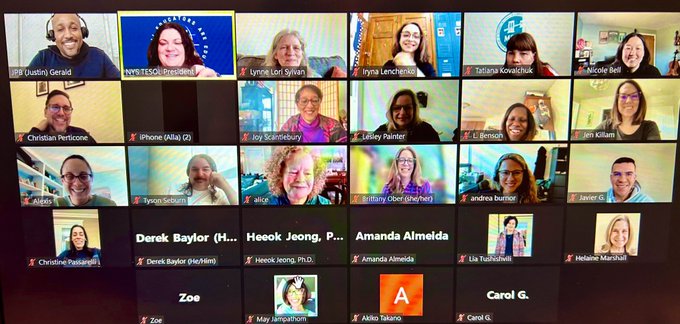
Photo Credit: Kimm Marchovich
Katie Leven is a wife, mom and itinerant ENL (English as a New Language) teacher with 18 years of experience in Western New York. She’s traveled to 12 different counties, and left part of her heart in Argentina with her host family there. She is fluent in Spanish, and previously taught levels I-V Spanish and French at the High School level. She currently works through BOCES (Board of Cooperative Education Services) to provide Stand Alone and Integrated ENL services to K-12 students, along with professional development to teachers of MLLs (multilingual learners). In 2023, she was named ENL Teacher Leader of the Year by the RBE-RN West! You can listen to her podcast, The Intentional TESOL, on Apple Podcasts and Spotify! She brings a variety of experiences and a ton of research to support any teacher who wants to learn more about language acquisition strategies and balanced literacy! She'll show you how to work smarter, not harder together for the benefit of ALL your learners!
Podcast: The Intentional TESOL
Made by: Katie Leven
Available on Apple and Spotify
Website: https://sites.google.com/view/
Overview
Who: Katie Leven (ESOL teacher-O/N BOCES), and Amanda Carbone (Grade 4-Starpoint CSD)
What: Integrated Guided Reading and RTI time-Grade 4
Where: Regan Intermediate School, Starpoint Central School District
When: This is the first year my co-teacher (5 years of experience) and I (17 years of experience) have worked together. 2022-2023 school year
Why: We wanted to balance grade level and instructional-level guided reading lessons.
Context of the Case Study:
My co-teacher and I co-teach grade four Guided Reading and RTI time. (overflow/advanced guided reading time). This allowed me time with my eight ELLs in the classroom: 1 second year commanding, 3 first year commanding and 4 expanding.
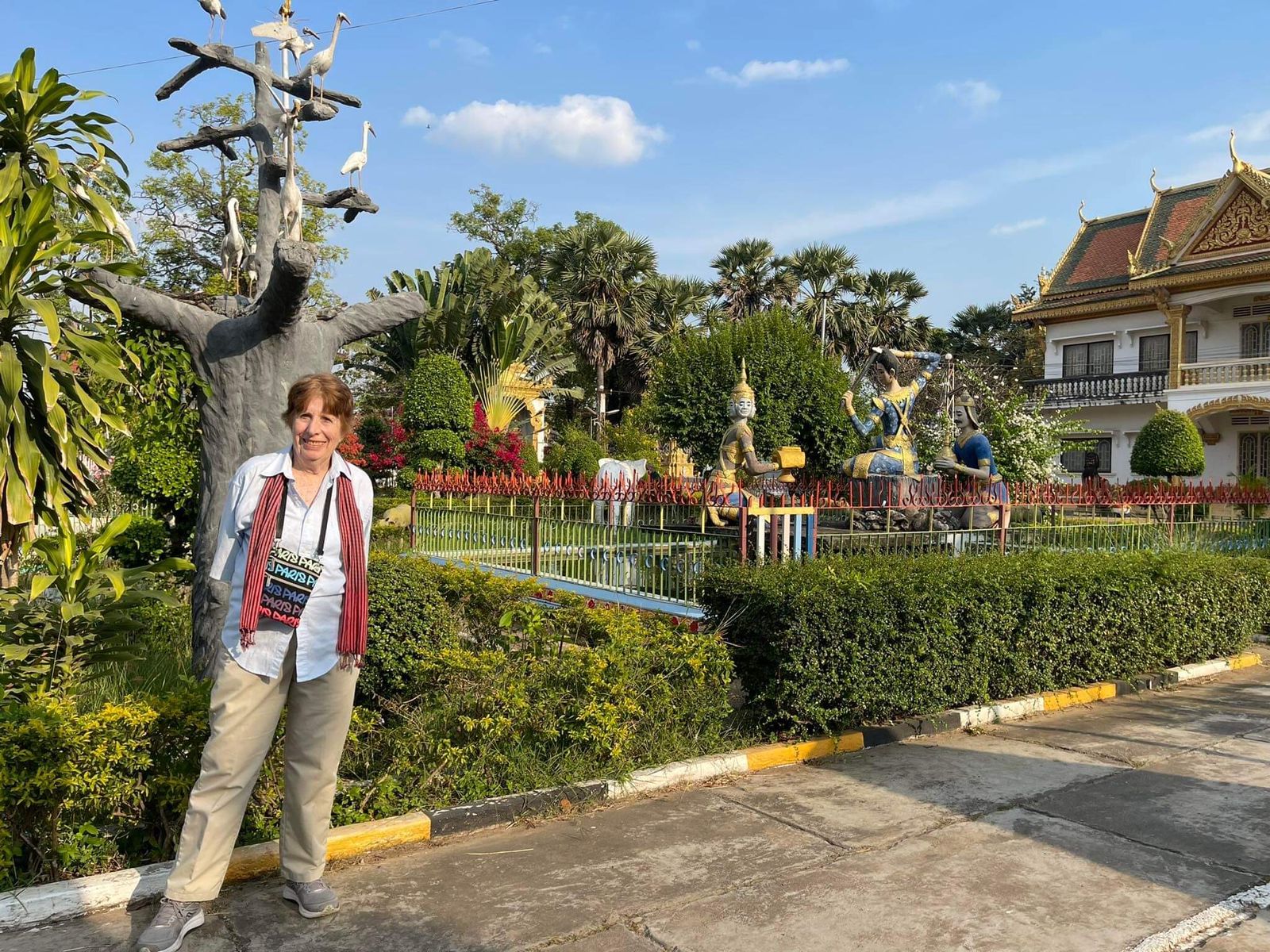
Virginia Jama
NYS TESOL Retiree
NYC ESL teacher retiree
Virginia Jama went to Cambodia recently upon an invitation from Dewey International. This piece narrates her teaching journey to Southeast Asia.
Students at Saugerties Senior High School proudly display flags from their home countries.
High Prep Discussion Protocols for English Language Learners
Every English as a New Language (ENL) teacher knows the importance of academic discussion, both for language development and critical thinking skills, but many have also experienced the frustration of asking students to talk about something, either as a whole class or in small groups, and hearing silence. The right strategies, however, with appropriate scaffolding and preparation, can make academic discussion far less daunting for both teachers and students. Building off of last year’s webinar on low prep discussion strategies, “Beyond Turn and Talk” (watch here), the Secondary SIG will be presenting a webinar on “High Prep Discussion Protocols for ELLs” (register here) on June 1 from 5:30-6:30 PM.
Anti-Racist Action is an Everyday Practice
Dana, Claire, JPB, and Alexis: The Anti-Racist Action Special Interest Group (ARA-SIG) consists of NYS TESOL members who have come together as language educators from many different contexts: adult education, higher education, K-12 education, and professional development spaces. Our schedules are hectic and difficult to coordinate, with work and family obligations and life in general, but every few months we make time to meet and plan a project to propel our SIG’s work forward. NYS TESOL brought us together, but what keeps us together is our shared commitment to seeing the world through a racial equity lens, and trying to get others to do the same in each of our lives. Below, some of us share how we are perceiving and confronting racial inequity in our everyday lives.
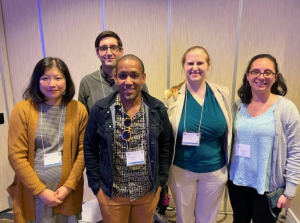
Jennifer Raponi is a Resource Specialist and the senior member of the Mid-West RBERN team. She was a preschool speech therapist before deciding to get her Masters in TESOL at the University of Rochester. Jennifer holds certifications in B-12 Speech and Language Disabilities, TESOL, and B-12 Literacy. She worked as a K-12 ESOL Teacher in Geneseo and started the original GV ESOL Teacher Cohort to support ELL education in rural districts. Jennifer also has the honor of teaching preservice teachers at Nazareth College and the State University College at Brockport. She is passionate about the equitable education of English Language Learners. Jennifer’s particular areas of interest and expertise are Students with Interrupted Formal Education, Literacy Development for English Language Learners, and collaborating with Districts to create effective and responsive programming for ELLs.
Shawnna Sweet is the Assistant Director for World Languages for the Greece Central School District. She is formerly an ESOL teacher and a professional development specialist with the Mid-West RBERN. Shawnna has also taught graduate courses in TESOL at Nazareth College and is the 2024 President Elect for NYS TESOL.
On February 25th, the 9th annual American Language Program (ALP) Winter Conference will take place at Columbia University. The ALP Winter Conference is a professional development event for practicing language educators, researchers, and graduate and doctoral students aimed at enriching their pedagogical practice in language teaching.
Each year since our first conference in 2015, we have selected a theme fundamental to language teaching, invited plenary speakers, and solicited participation from the teaching community. We have been fortunate to have welcomed a number of memorable guest speakers at this event, including Scott Thornbury on learning and teaching grammar, Gabriel Díaz Maggioli on professional development, Shelley Saltzman on curricula & materials, Lesley Painter-Farrell on teaching learners how to learn, Frances Boyd on vocabulary acquisition, and Linda Lane on pronunciation pedagogy. In addition to these plenary presentations, the conference has facilitated talks by speakers from a variety of teaching contexts sharing their experiences, research, and ideas about pedagogy. Ultimately, the Winter Conference is a beneficial opportunity for members of the TESOL community in the New York City region to engage in professional development by delivering presentations, attending a variety of talks, and networking with others in the language teaching community.
This year’s event focuses on the role of assessment in language learning, specifically assessment for learning. Grabe (2009) defines assessment for learning as “the notion that assessment should be used to promote learning” and an approach that incorporates "teaching procedures that use assessment information as major opportunities for learning and the development of more effective skills over time” (p. 363.) Assessing students effectively can provide meaningful information about their learning that can inform teachers’ pedagogy. However, doing effective assessment is both complex and challenging, and when it’s not done effectively, can lead to negative washback for learners and teachers alike. Thus, this year’s ALP Winter Conference will provide a platform for language teachers to engage with this challenging area of practice, and hopefully come away with new insights and understanding on how to do assessment more effectively.
General admission tickets to this year's conference are available and can be purchased through our Eventbrite page.
Senior Lecturer in Language | American Language Program
Natasha Welcome M.Ed
Metamorphosis Education Consultants
Interview: Finding Courage and Hope in the Darkest of Times
Елена Лукина and Ching-Ching Lin
Елена & her daughter, Dasha
Dear Readers,
The NYS TESOL MOSAIC, 53,11-18 highlighted four pieces of gratitude from our award winners. They each explained what the NYS TESOL award meant to them, personally and professionally.
Here, you will enjoy an additional token of gratitude on behalf of ALL the awardees:

Sandra Vagas-Ortega, Ph.D.
Ph.D. Second Language Acquisition Research
English as a New Language Educator
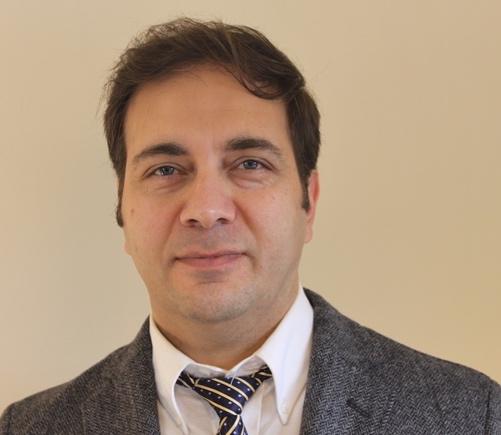
Ali Safivand, Ph.D.
Education & English Language Pedagogy
NYS TESOL VP Conference elect
Through this blog post, it is with great joy that I introduce ALi Safivand, our 2022-2023 VP Conference Elect.
Our newly elected leaders were asked to share a little bit about themselves and how their service will support NYS TESOL and its vision: “All Educators are Educators of ELLs.”
Here is Ali Safivand shared:

Christine Passarelli
ENL Teacher
VP of Advocacy
Through this blog post, it is with great joy that I introduce Christine Passarelli, our 2022-2023 newly elected VP of Advocacy.
Our newly elected leaders were asked to share a little bit about themselves and how their service will support NYS TESOL and its vision: “All Educators are Educators of ELLs.”
Here is what Christine Passarelli shared.
12/20/2022
Dear Readers,
Warm greetings! As we prepare to welcome another new year, which I am confident will be filled with many wonderful things, I would like to wish everyone all the best during this holiday season.
It is an immense pleasure to present and welcome NYS TESOL’s 2023 Newly Elected Leaders:
VP Conference Elect: Ali Safivand
VP Conference: Sandra Vargas-Ortega
VP Finance: Jinna Hyunjin KIM
VP Advocacy: Christine Passarelli
Interview with Christine Seebach
Volunteering for NYSTESOL is an honor, a pleasure, and a true commitment. I sat down with Christine, our President-Elect, to ask her why she volunteers.
1. Why did you join NYSTESOL, and subsequently take on a leadership role?
I began to learn about NYS TESOL during my TESOL Master’s program at NYU. Dr. Miriam Eisenstein Ebsworth was my professor. She was very influential throughout our program. It was in our MA TESOL program that she thoroughly promoted NYS TESOL and got many future teachers of ESOL involved. Dr. Eisenstein Ebsworth has been a major leader and participant in NYS TESOL throughout the decades. Another leader who I had the pleasure of meeting at different events is Susanne Marcus. She, too, has been a major leader and participant in NYS TESOL throughout the decades. Both Miriam and Susanne are past presidents of NYS TESOL. Their wealth of knowledge, research, passion, experiences, dedication, and kindness, has inspired me to take on a leadership role. What has also inspired me to take on a second leadership role on our executive board is the expertise, kindness, reliability, and support from our current and past EB members. Our past president Juliette Luther once pointed out: We are called “NYS TESOL” because we are nice.
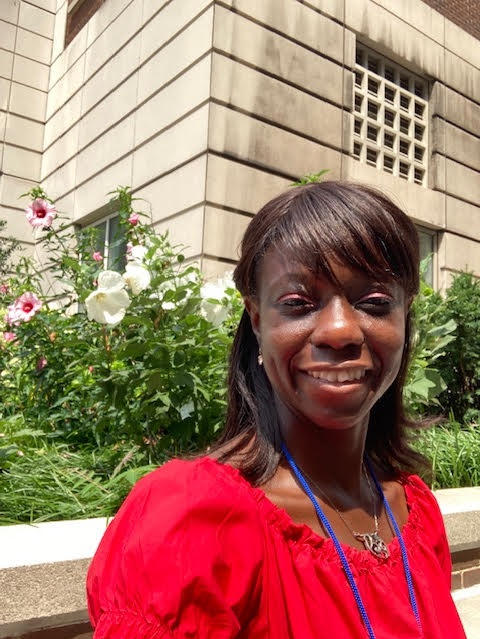
I sat down with our VP Conference to find out more about her motivation for taking on a leadership role in NYS TESOL.
1. Why did you join NYS TESOL and subsequently take on a leadership role?
Joining NYS TESOL was a way for me to connect with like-minded people in terms of their dedication to the ESL/EFL profession. Professional environments differ, and sometimes you need a connection outside of your colleague bubble for fresh ideas, additional professional development, to have more of a pulse on what's out there in terms of opportunities in the field, and of course, to develop new friendships.
2. What do you think NYS TESOL's role is in the teaching community? What should it do for members?
NYS TESOL provides support for teachers from all realms of education. It provides an opportunity for educators to grow and learn from each other in a nurturing environment while also allowing for the exploration of talents other than teaching. For example, maybe you'd like to try your hand at writing for industry publications, so you reach out to a fellow member who has done this and can provide some insight as to how to get started.
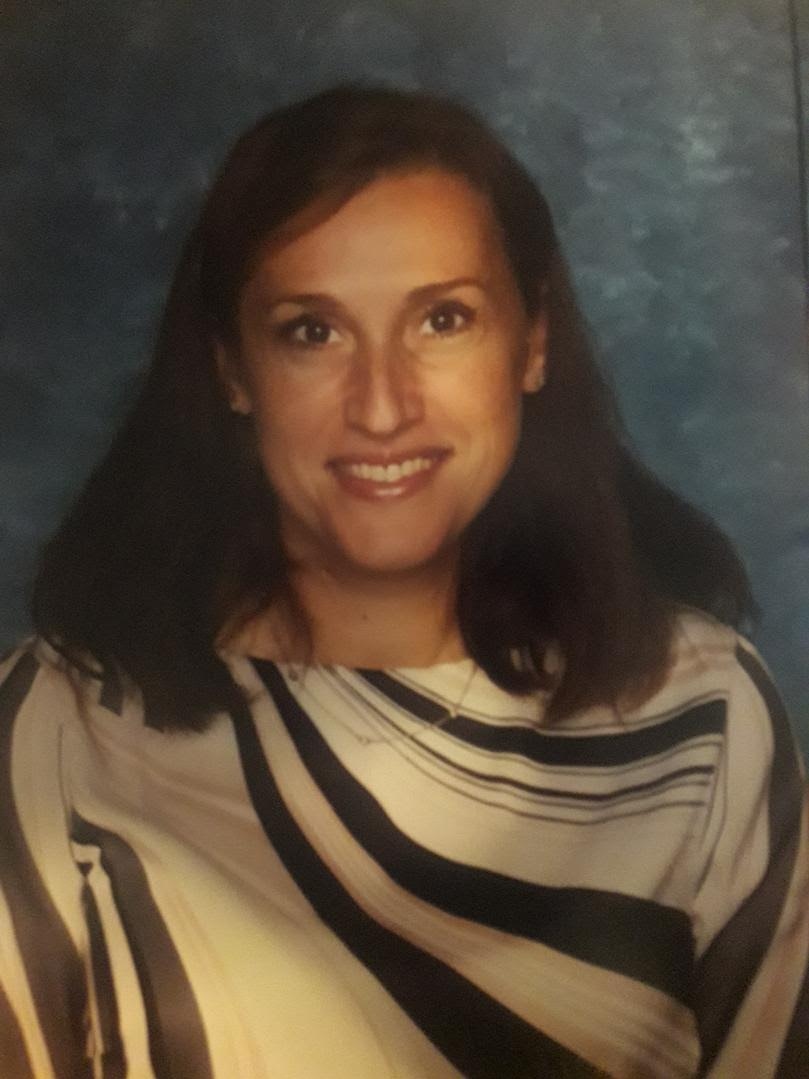
By Yana Shifrina
Research conducted over the past years has yielded the vast bulk of evidence concerning the benefits of bilingualism. Leikin and Tovli (2014) demonstrated the connection between bilingualism and creativity in early childhood by examining the possible effect of bilingualism on problem-solving creativity in non-mathematical and mathematical tasks. After administering creative-thinking tasks, a verbal fluency test, and equal number tasks, the results revealed that bilingual children had higher scores in nonverbal creative behavior. However, Leikin and Tovli found that monolinguals do better than bilinguals on verbal creativity measures (2014). The investigators concluded that the “relationship between bilingualism and superior divergent skills seemed to relate to the level of language proficiency” (p.412). Overall, the study established that balanced bilingualism had a positive effect on various domains of creativity, such as verbal, general, and mathematical.
Interview with the NYSTESOL President Ching-Ching Lin
Is it about a month since you became president? How is it going so far?
As you know, we all have some kind of goal, so I also have this internal clock. I say, oh, two months have passed, and what have I done? So we all have some kind of goal, and we have to find a way to operationalize it. I used the word to operationalize because I feel I am dealing with a machine in a way. Including myself - I am a machine and a work in progress, you know I continue to discover new dimensions about myself, I continue to learn about myself and engage my own identities. I also try to find my own voice—for example, the Monday Memo. I spend time on the memo, finding a topic to talk about, and trying to find my own voice.
I also have learned about the various NYSTESOL systems such as Memberleap; it has been a steep learning curve.
We have six strong leadership teams: Advocacy, Membership, Communications, Outreach, Finance, SIGs, and Regions. I have met with each one. I am working hard to make sure that we are all in sync. In addition, I want each team to have specific strategic plans so that we can build a better machine, which runs more effectively.
Susanne Marcus
When we gather as K-12 ELL teachers, we often agree that the safest place for our immigrant students to open up is in our classrooms, the ELL classroom, the one full of others facing the same challenge or enemy-at-large. But it’s more than that. One obvious unspoken fact is that each of them has taken a deep journey far from loved ones only to arrive in a new place with new ways of communicating, eating, dressing, and being. Their stories often share common threads depending on where our ELLs hail from. Separation, loss, anger, disappointment, confusion, depression......floods of emotions that are usually too much to contain while trying to decipher the English noise around them.
As we develop bonds of trust between and amongst our students, stories unfold. In pieces, in moments, in flashbacks, bus rides, in conversations, trips, memories...
These bonds of trust are the foundations upon which our relationships are built. We experience these relationships most strongly in our ENL classes, whether they are stand-alone, collaborative, team-taught, or what. Many of us think that we have carte blanche on the strongest connections to our ELLs as ENL teachers.
And, in my 30-plus years of teaching experience, I have witnessed this as my reality.
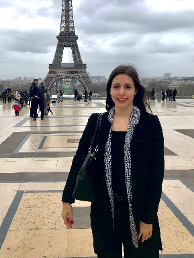 TESOL Candidate Pamela Leuchtman on Academic Language and ELLs: What Teachers Need to Know
TESOL Candidate Pamela Leuchtman on Academic Language and ELLs: What Teachers Need to Know
By Jasmin(Bey) Cowin, Ed.D. Assistant Professor and TESIOL Practicum Coordinator, Touro College, GSE, NY
Discussion Boards (DBs) offer the opportunity to not only to reflect on readings but also contribute with peer responses to the learning process of the course cohort. It is through DBs that I meet my Touro TESOL teacher candidates in asynchronous courses and have the opportunity to interact with them. Online discussion is defined as communication between instructors and students using interactive communication tools. Touro’s LMS Canvas offers multiple online communication tools from video, media and voice recordings to uploading of images, and chats.
Conflicting Research Results on Facilitator Presence in Discussion Boards
Research supports two interesting results that could conflict with each other in practice; that instructor presence is key to student satisfaction, and intensive interaction and too many posts by the facilitator in discussion boards can lead to reduced posting by the students (Wang and Chen, 2011). Students report greater satisfaction in courses that have facilitator presence and availability (Picciano, 2002). On the other hand, because the instructor is considered an authoritarian symbol (Rourke & Anderson, 2002), studies found early and often postings by an instructor resulted in less frequent and shorter posts by the students (Dennen, 2005). Students need autonomy and feeling safe in expressing their views with each other before instructor interaction otherwise they write for the instructor, and not to each other (Wang and Liang, 2011).
I do not “participate” in the DB’s but interact and write to the candidates in the grading responses in Canvas. However, I (Jasmin Cowin) let the group know that I am reading everything they write posting encouraging responses or asking a follow-up question.
My Discussion Board Guide:
- Copy and paste the questions and answer under them so I can see you answered to all points - a model is provided in this post.
- I recommend you post by Friday of each week, so you have time to give thoughtful peer responses.
- Please note that 2 thoughtful peer responses per discussion board are needed for meets expectations (3 points), more than 2 peer response is above expectations. - I provide a model for both the post and response below.
- All quotes and references must be provided at the end of your DB in a reference section. - you can use https://www.citationmachine.net/ (Links to an external site.)
- Please read the rubric!
Read Touro TESOL Candidate Pamela Leuchtman's reflection on academic language and ELLs.
Reflections on Defining Multicultural Education for School Reform
Elias Tavares, Touro College, GSE, TESOL Advanced Certificate Program
Introduction:
As Touro TESOL/Bilingual teacher candidates prepare for their vital work in TESOL/Bilingual education, it is essential that they take an active role in their professional and personal growth through reflection. A critical component of their journey at Touro College, GSE, TESOL/Bilingual Programs are reflective journals. “Journals often focus subjectively on personal experiences, reactions, and reflections while learning logs are more documentary records of students’ work process (what they are doing), their accomplishments, ideas, or questions” (Equipped for the Future, 2004).
Articulating subjective reactions help candidates identify key learning events. Elias Tavares’ journal Reflections: Defining Multicultural Education for School Reform was both analytical and descriptive. His focus on Multicultural Education for School Reform was selective rather than comprehensive. Mr. Tavares supported his analysis with evidence and references to wider reading while keeping the tone of his writing personal, not rhetorical.
References:
Equipped for the Future (2004). Teaching/Learning Toolkit. Learning logs. http://eff.cls.utk.edu/toolkit/tools_learning_logs.htm
Touro TESOL/Bilingual candidate Elias Y. Taveras reflects on Defining Multicultural Education for School Reform
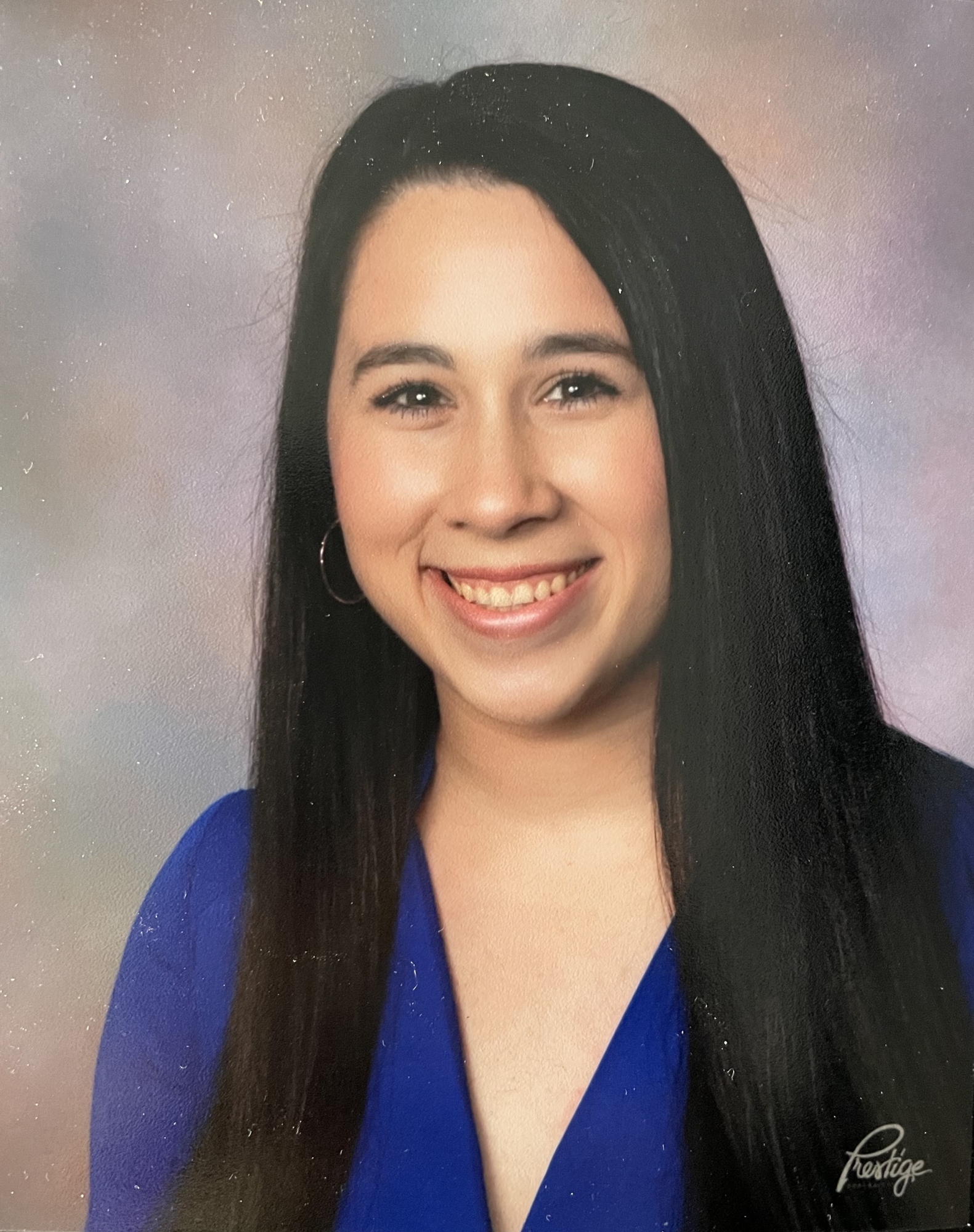 My Journey Navigating Strengths-based Teaching: A Global Activists Project
My Journey Navigating Strengths-based Teaching: A Global Activists Project
By Alex Itzler, a NYS School Teacher
With a growing diverse population in schools and communities, there is a greater emphasis on multilingual education. As educators, it is our job to challenge ideologies favoring monolingualism. There are numerous students in my classroom that speak multiple languages, and it is up to me to utilize this asset in the classroom.
As a native English speaker, myself, I never truly thought about the challenges multilingual learners face on a daily basis. These students are adapting to a new classroom, peers, environment, all while learning an unfamiliar language. I now understand that a multilingual approach can educate teachers and give insight into the students' linguistic and literacy practices and patterns. Multilingual learners new to a language may find conjugating verbs or utilizing certain vocabulary challenging. When I began learning Spanish as a second language, remembering the meanings of vocabulary words was something I found challenging. It wasn't until my teacher showed me English and Spanish cognates that I began to make sense of the vocabulary. Using both languages allowed me to strengthen my understanding of vocabulary in my L1 and L2.
With the growing number of classrooms filled with diverse learners, I believe it is essential that teachers create an inclusive classroom. Each student brings a unique cultural background and perspective that can be utilized to enrich their learning process. This semester I had the opportunity to interview two multilingual students who are entering the fifth grade come the fall. Through these interviews, I was able to learn a great deal regarding the students' backgrounds and their literacy and language skills. I was able to utilize this knowledge to create appropriate supports and incorporate student interests. For example, I learned that my students feel comfortable speaking their native language when speaking with friends in my interview. As a result, I tried to incorporate numerous opportunities for partnerships throughout my unit. Additionally, I learned that my students are very familiar with technology. In my Thematic unit, I want to build on this knowledge during research and learning experiences.
Age discrimination is alive and well in our profession.
Anonymous
A 65-year-old veteran adult ESOL teacher of 14.5 years in New York City
Age discrimination is alive and well in our profession. We know that technology reigned during the pandemic. It was necessary to anchor students to a learning community, and sometimes, students did increase their English skills. Yet, technology has also become the excuse for laying off experienced and dedicated ESOL teachers, teachers that were trained to teach in a classroom and then made heroic shifts to the online environment, and were effective in both domains.
Barriers to ELL Graduation
By Shawnna Sweet, Professional Development Specialist
This spring, community stakeholders from Rochester and other places across New York State engaged in a community forum to discuss the
barriers to ELL graduation. The event was organized by the Mid-West Regional Bilingual Education Resource Network (RBERN) and The Children's
Agenda, a non-profit organization that advocates for policies and solutions for children's health, education, and success. This virtual forum was
conducted using Zoom's simultaneous interpretation, so participants were able to choose to engage in English or Spanish. Participants' roles ranged from educators, school and district administrators, former ELL students, parents, and community members. The entire community forum event consisted of expert presentations, a panel discussion, and small group discussions.
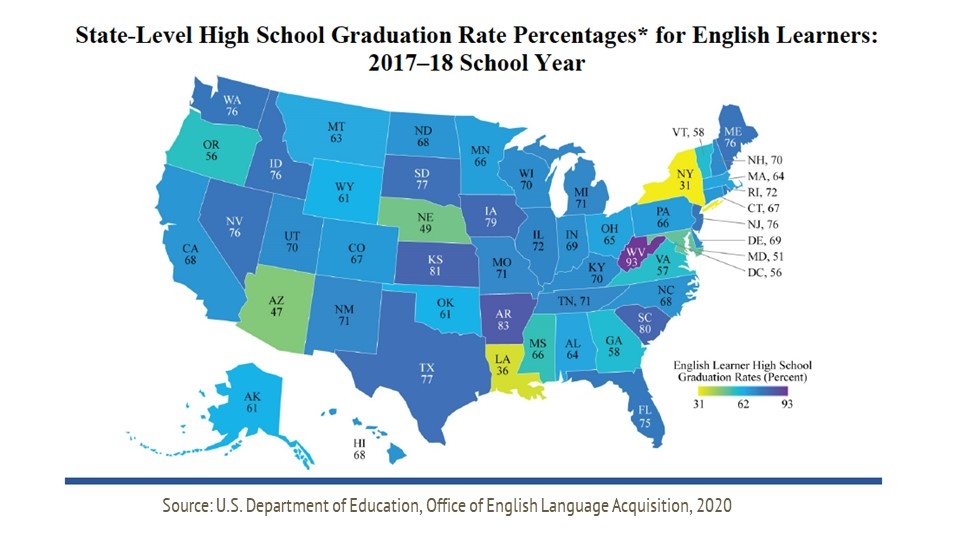
Language Ideologies and Practices in Classroom Reading Assessments
By Laura Ascenzi-Moreno
I start this blog post with a picture of a running record kit in Spanish, commonly used in New York City, where I was a teacher and now work as a teacher educator. This picture is significant because, for me, it symbolizes the complicated relationship between teachers and classroom assessments. As a dual language bilingual teacher, I was asked to conduct running record assessments - a measure used to assess students’ reading abilities - in English and Spanish three times a year and afterward to hand in students’ independent reading levels to the administration. Conducting these assessments took a lot of instructional time, and while assessing student reading is critical, kits like these only came out at particular, prescribed times or otherwise were stored in closets, under tables - far from the action of classroom life. While so much effort is put into assessing all students, there simply was not enough time to examine the data to understand readers beyond their reading level and, in particular, to truly examine children as multilingual readers.
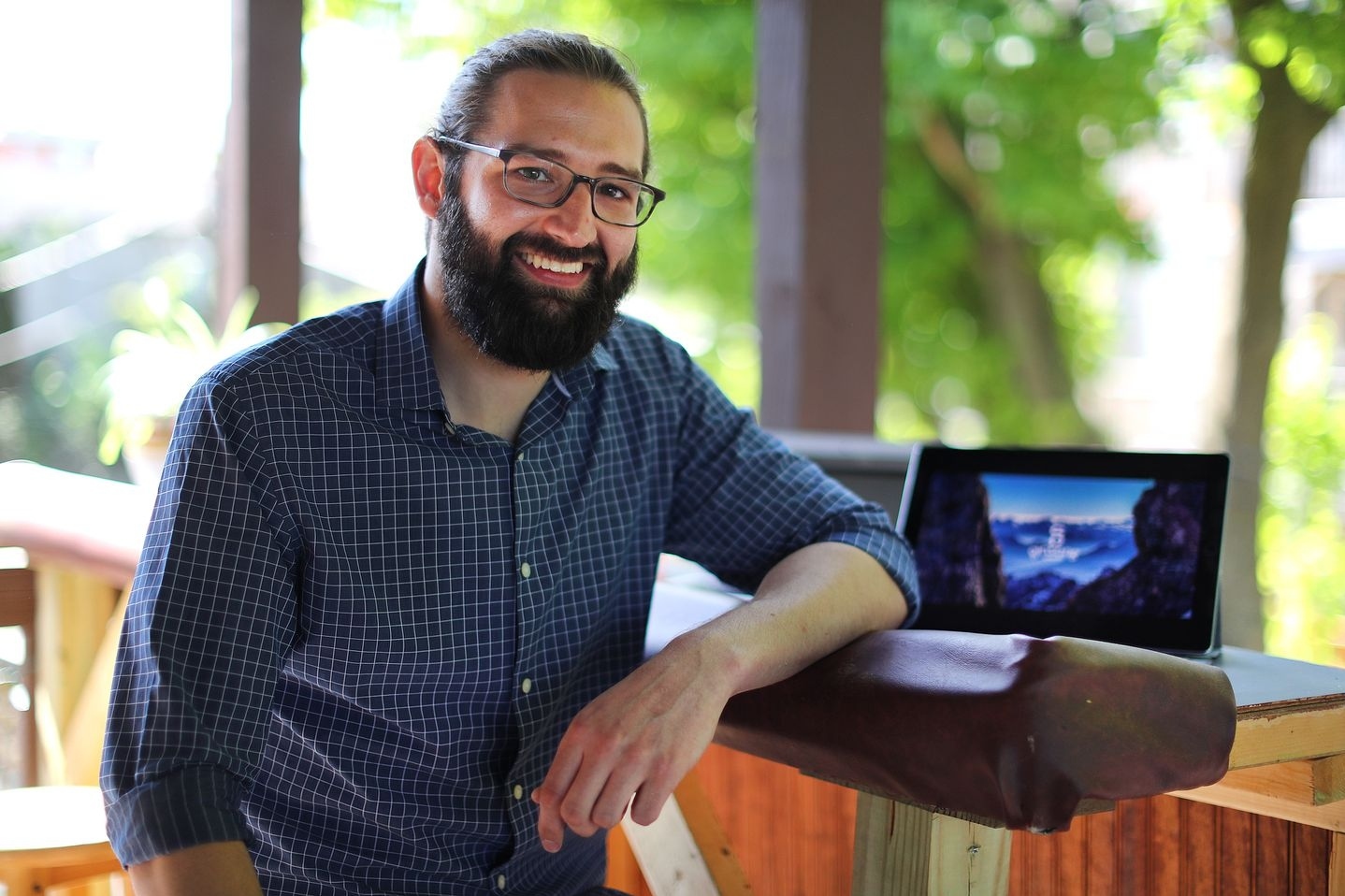 Locating Anti-Racism in the ESL Curriculum
Locating Anti-Racism in the ESL Curriculum
By Rob Sheppard
In this post, a follow-up to JPB Gerald’s post on this same blog, I discuss where ESL curriculum developers can integrate anti-racist work into an ESL curriculum.
A Preamble
Let me start with this: when asked to write a follow-up to Justin’s post on decentering Whiteness, I first thought, Me? Are you sure you should be asking cishet white male “native-speaking” me? It felt that white people writing about decentering whiteness could run the risk of inadvertently recentering whiteness. Upon further reflection, though, I remembered that white people are supposed to be shouldering the bulk of this weight of the anti-racist work, and this necessarily involves doing some writing and speaking. I reached out to Justin to get his thoughts on the matter and here’s what he said:
'If racialized people had the power to solve these problems alone, we wouldn't have these problems. This work will require white educators challenging whiteness alongside us. Just be thoughtful and open as you engage in your necessary pushback.'
I’ve still got a lot to figure out, but I hope I have something of value to contribute on the intersection of anti-racism and the topic most central to my work: ESL curriculum design.
Does Anti-Racism Belong in an ESL Curriculum?
I don’t think it’s unreasonable to ask in good faith whether anti-racism has a place in the ESL curriculum. In most contexts and programs, though, my answer to this question is an emphatic yes. Here are a few reasons why that is.
For one thing, racism is pervasive. In my fifteen years in the ESL classroom, I’ve seen racism, anti-Blackness, anti-Semitism, and Islamophobia (not to mention homophobia and transphobia) crop up more times and in more ugly forms than I care to count. The task of rooting out and eradicating racism requires a far-reaching, multi-front approach, one that certainly includes the classrooms where it continues to rear its head.
More specifically, though, the field of English language teaching is one uniquely rooted in colonialism, and thus bound up with various forms of racism in ways that go far deeper than “racism is everywhere.” If there is anywhere that whiteness is still shamelessly centered, it is in the field of English language teaching. Take a look at an ESL coursebook. Look at which Englishes are taught and assigned prestige. Look at which accents are upheld as “neutral” Examine what “professionalism” is code for. Incorporating anti-racism as a partial corrective into the ESL curriculum ranks among The Least We Can Do.
There are those among us who believe that simply by doing “good work” like ESL with pure hearts and good intentions, that we have clean hands and clear consciences and that this anti-racist stuff can be for someone else to do. Gerald (2020) terms this the “altruistic shield.” It is a dangerous complacency, and we need to work to disabuse ourselves and our peers of it.
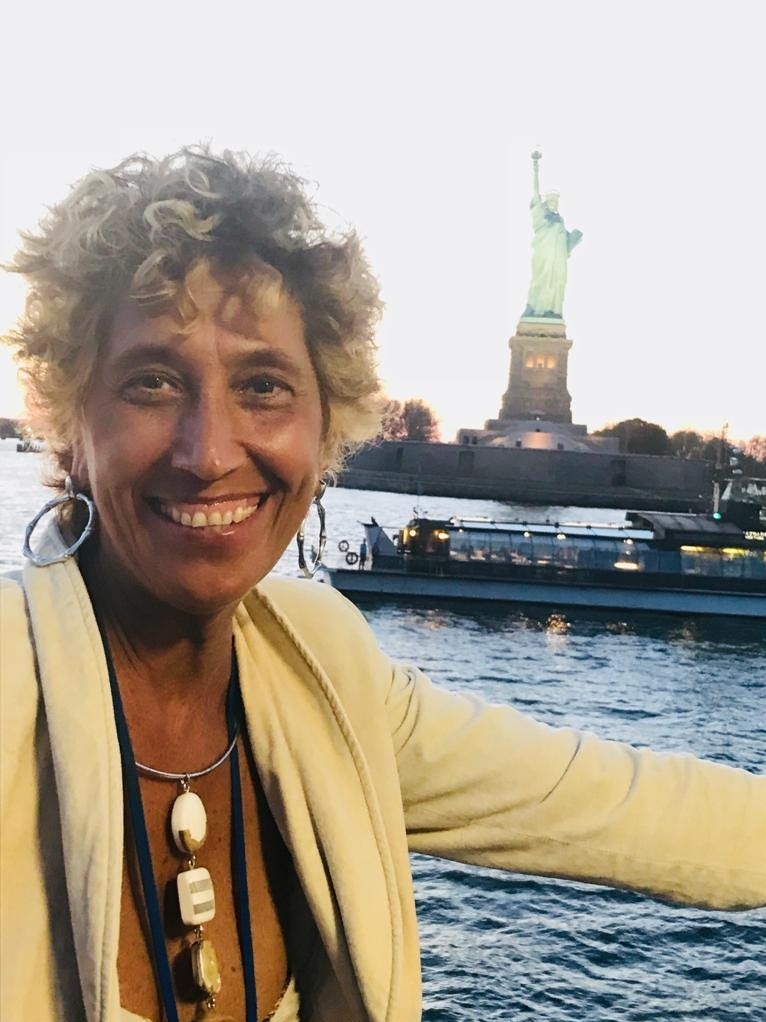 Guiding Principles and Best Practices for Dual Language Education with Dr. Lucia Buttaro
Guiding Principles and Best Practices for Dual Language Education with Dr. Lucia Buttaro
Last week, I held a virtual webinar on dual-language programs. I know that there are a lot of presentations out there on the topic, but I wanted to provide a more practical aspect (peppered with research, of course). I wanted to make sure the audience walked away with a better understanding of how to implement a successful one. For example, in my experience, prior to COVID, I was in school districts that opted to stop teaching in Spanish just because of the state standardized testing in English. If this takes place, then we are not being faithful to the model. Teaching for biliteracy is quite different from teaching for monolingual literacy. Another aspect that was discussed was the cultural component: Both administrators and teachers must be familiar with the cultural, linguistic, and educational backgrounds of the students in their building. Since the goal is to help students become bilingual, bi-literate, and bicultural, cross-cultural awareness for both languages is a must.
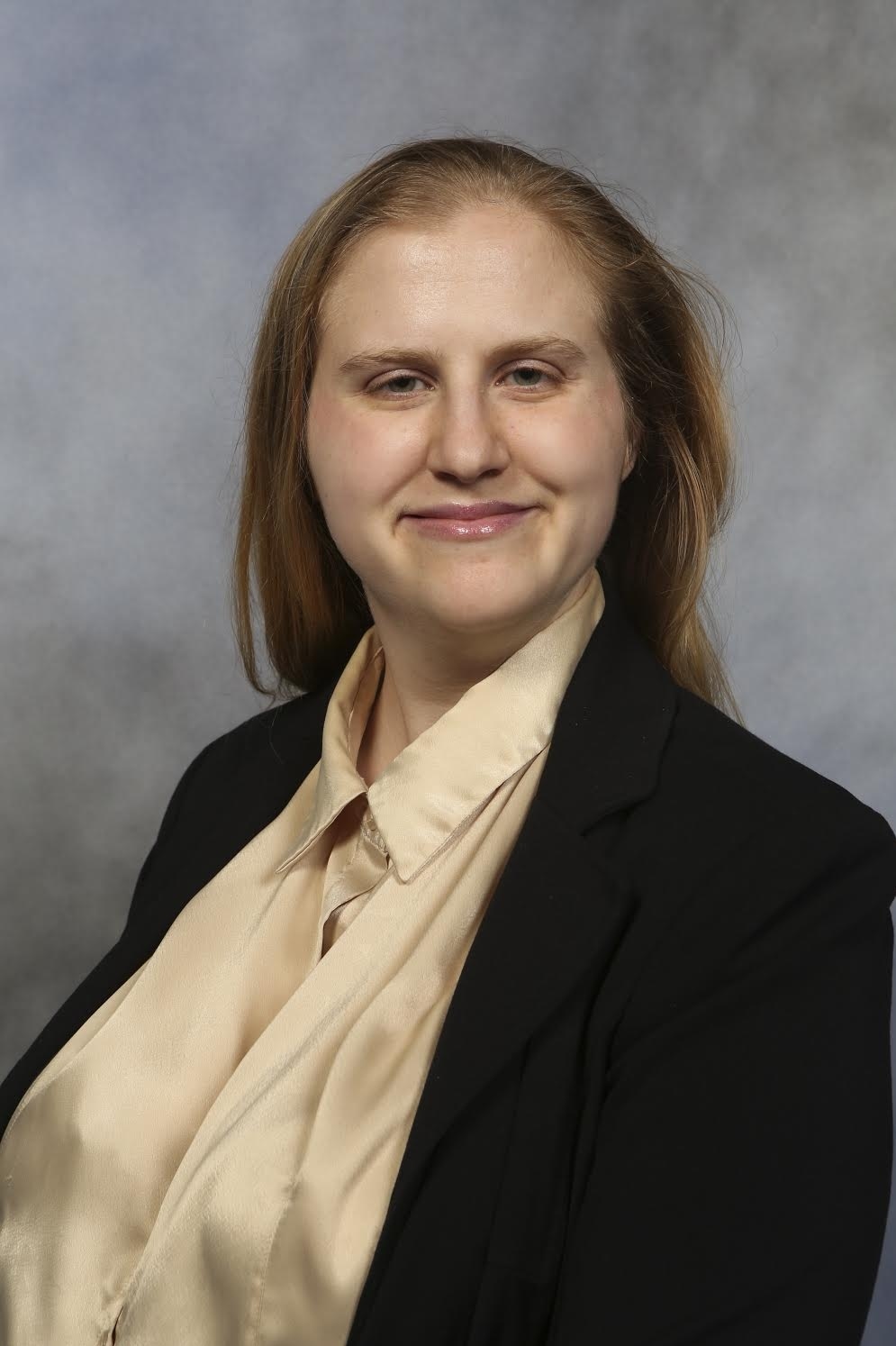 An IEP in the Pandemic
An IEP in the Pandemic
By Claire Fisher
The first sign of trouble was a student whose cousin got forcibly quarantined because of suspected exposure to a new coronavirus. She had a panic attack worrying about him and didn't feel up to attending our regular Intensive English Program (IEP) session. I responded to her email with my standard "feel better; the homework is X."
There had been reports and headlines for weeks about something going on in China, where most of my students were from. Some had mentioned how they were happy they had flown to NYC the week before the lockdown. Although the news was scary, it all seemed very far away - until it wasn't. Like so many others, my institution's changes happened without warning, with minimal interdepartmental coordination, and so quickly that it felt like all our plans unraveled overnight. In my final in-person class, I reassured students that they weren't being kicked out of the country and that classes weren't canceled. "You'll just be doing online courses from your dorms, on your normal schedule," I insisted. Two days later, the dorms closed indefinitely. I spent that last class training students on Google Classroom, but I shouldn't have bothered: within a week, all but one of them had moved back to Chinna and behind China's Great Firewall, where there is no legal access to Google. There was no time to even write a school policy on how to handle students in different time zones. Most of my Chinese students attended courses from 8 PM-8 AM, yawning into their screens from the quarantine hotels where they were staying, waiting for test results.
 Tools and Techniques for Online Learning in Elementary School
Tools and Techniques for Online Learning in Elementary School
By Kathy Moore
Last spring, when New York City Public School buildings closed and all classes moved to remote instruction, my elementary school students and I suddenly had to transition to an entirely new way of teaching and learning. I had never used Google Classroom, and many of my students and their families had limited experience with technology. To my surprise, I learned a tremendous amount during this time. I discovered tools to engage students remotely and make online learning as interactive as possible. I will discuss three of the most useful of these resources here.
Jamboard is an interactive digital whiteboard that provides “sticky notes” to write on, markers for drawing, and the ability to attach images from the web. It’s useful for a variety of purposes. Students can participate in collaborative written discussions. For example, my third-grade students use Jamboard to share opinions on topics such as whether snow days should be remote school days or whether video games are sports. Responding on Jamboard allows students quiet moments to reflect and formulate opinions. Students can also play games like Pictionary on Jamboard and participate in activities like matching words and definitions or sequencing events. With beginners and SIFEs (Students with Interrupted Formal Education), I use Jamboard for shared writing lessons. A beginner student and I created a Jamboard to describe how she baked a coconut cake with her mother. We included pictures of ingredients that we also labeled, and then we wrote the procedure.
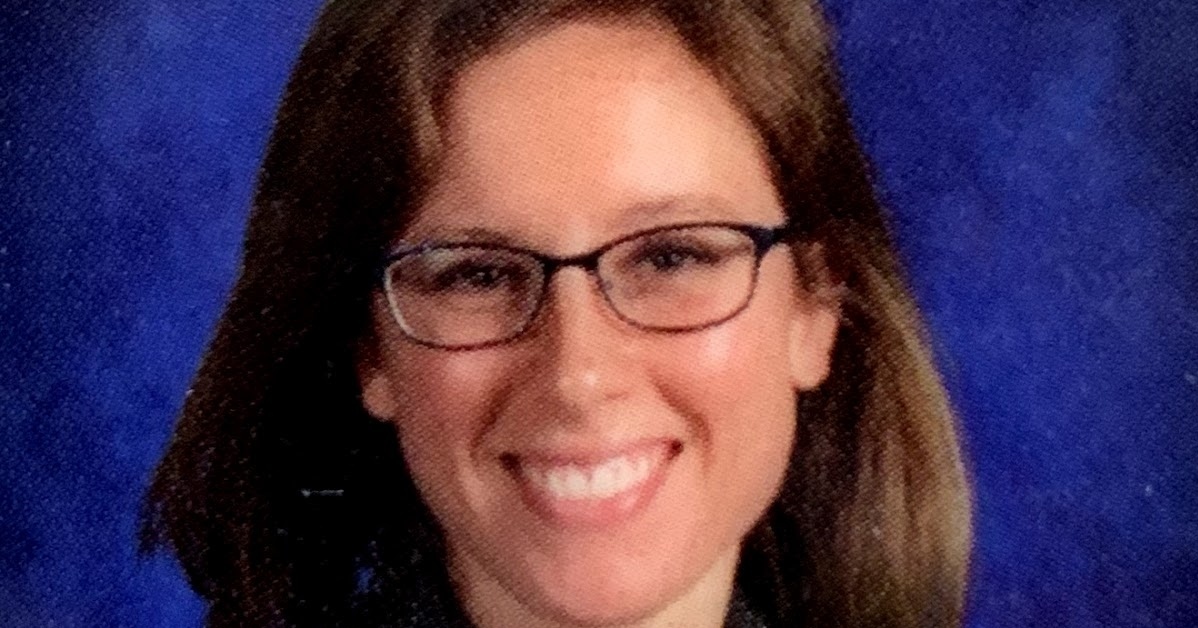 Structuring your Standalone Time by Katie Leven
Structuring your Standalone Time by Katie Leven
Who wouldn’t want a less stressful day? Who wouldn’t want their day to just flow? The key to that is to simplify, simplify, simplify! When you teach across four buildings a day, you learn the key is having routines, routines, routines!
In my Standalone ENL classroom, I have the most opportunity to help my emergent bilinguals where they are at and to bring them up to the grade-level curriculum. I want them to feel successful. I want them to grow as quickly and painlessly as possible. I know the choices I make are the key to all of this. Therefore, I need to pack in as much learning as I can into our 40 minutes together.
First, I welcome them to my classroom and check-in about their day. This is to give them a chance to talk, express their emotions, and build relationships, so they feel connected. Tan Huynh gives some great ideas in his blogpost about incorporating Social and Emotional Learning. I have an anchor chart on the wall for my lowest learners, which contains sentence starters for support. Learners can use either Google or Microsoft translate if they are feeling emotions that are difficult to express. The learners can play the translation aloud as a model for future communication while maintaining a social distance. That way, their feelings are being understood if they speak a language, I don’t.
Best Practices for Integrating Social-Emotional Learning into Newcomer Classrooms by Lisa Auslander & Virginia Skrelja
In our many years of experience working with schools that serve adolescent Newcomer ELs, we became aware of the challenges students experience before, during, and after the immigration process. For example, in research interviews and focus groups with both teachers and students, we learned that a large number of our undocumented students had crossed the border unaccompanied, lost loved ones along the way, and were no longer as connected to family members or a social network. Once these students arrive, their troubles often are not over. Court dates and paperwork interrupt regular school days, and older students often need to have part-time jobs in order to make ends meet. Newcomer immigrant students may end up working at night and attending school during the day which increases their likelihood of dropping out. Students often face other hurdles, now exacerbated by COVID-19, such as negative stereotyping, transience in their home lives, and food insecurity (Auslander, 2019, pp. 18-24). Research also showed a tendency toward understaffing, particularly in the areas of counseling and social work. The average ratio of social workers and school counselors to students is very steep nationally at around 1 counselor to 482 students (NACAC & ASCA, 2015) In addition to the struggles that come with immigration contexts, we have also found that students can benefit from their immigration experiences. As a result of their life experiences, adolescent newcomers often develop resilience and life skills that other students their age do not possess. Teachers can leverage these skills as well as student interests in the classroom.
Social-emotional learning (SEL) can help Newcomer ELs deal with the many challenges they face as well as further develop skills that will help them progress as adolescent learners . CASEL defines SEL as learning and applying the knowledge, skills, and attitudes to develop healthy identities, manage emotions and achieve personal and collective goals, feel and show empathy for others, establish and maintain supportive relationships, and make responsible and caring decisions'' (CASEL , 2021). Here we provide a few strategies for teachers to integrate these skills into classroom learning to provide Newcomer ELs with the opportunity to become more successful in school and in their lives.
 Decent(e)ring Whiteness in ELT: Context and Terminology by JPB Gerald
Decent(e)ring Whiteness in ELT: Context and Terminology by JPB Gerald
At the end of last spring, my article, Worth the Risk: Towards Decentring Whiteness in English Language Teaching, was published in the BC TEAL journal (which you can read here). As the title suggests, the article focuses on the ways in which whiteness is centered in our field, the harm that this causes, and how we can go about decentering it. In one of those accidents of history, the article was released to the public the same week as the beginning of the ongoing uprising against racial injustice, and has led to my presenting on the topic throughout the summer, fall, and winter, including at the NYS TESOL conference. As much as I would like to believe in the pure brilliance of my work, clearly the article became more relevant than I could have expected when I wrote it last January, and, I hope, it has begun, or furthered, a necessary conversation in our field. Rather than rehash the arguments made in the article proper, however, I write today to provide some context on terms that many of us use frequently, which should help clear up some of the questions people tend to have when they hear about my scholarship. Let‘s start by talking about a fun topic that makes everyone comfortable.
 Helaine Marshall - 50th Anniversary NYS TESOL Conference Presenter (2020)
Helaine Marshall - 50th Anniversary NYS TESOL Conference Presenter (2020)
We asked NYS TESOL 2020 presenters to answer a few questions about the unique times we are living in. Here is what Helaine shared.
In what ways does your work support, celebrate, and validate multilingual learners’ cultural, racial, and linguistic assets?
The Mutually Adaptive Learning Paradigm® or MALP® supports some of our most vulnerable students by blending the learning paradigms from their cultures with the learning paradigm most common in our classrooms here in the U.S. We accomplish this by creating fertile spaces for learning with the 4 E’s: Equity, Enrichment, Engagement, and Empowerment. MALP builds equity because it is mutually adaptive and culturally sustaining. It encourages motivation because MALP is project-based to provide an enriching learning experience. MALP fosters active participation by students who often stay on the sidelines by engaging them in meaningful, targeted academic ways of thinking with culturally familiar content, full use of their multilingual repertoire, and culturally responsive learning activities. Finally, students feel empowered by the presence of the first three E’s and ultimately take ownership of their learning.
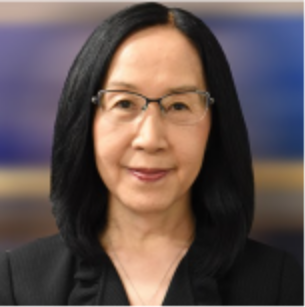 Okhee Lee - 50th Anniversary NYS TESOL Conference Presenter (2020)
Okhee Lee - 50th Anniversary NYS TESOL Conference Presenter (2020)
We asked NYS TESOL 2020 presenters to answer a few questions about the unique times we are living in. Here is what Okhee Lee shared.
In what ways does your work support, celebrate, and validate multilingual learners‘ cultural, racial, and linguistic assets?
The new science standards place equity at the center, thus all standards, all students. To achieve this vision, traditional approaches give way to contemporary views in teaching science. Traditionally, scientists and science teachers defined canonical knowledge of science disciplines as they were typically presented in science textbooks. Some students learned science, but science did not make sense to many students. The contemporary approach is tailored for all students to make sense of phenomena or design solutions to problems just as scientists and engineers do in their work. As multilingual learners use language to do science, they develop their science understanding and English language proficiency in tandem. Thus, science learning and language learning are mutually supportive of each other with all students, especially multilingual learners, by using their full range of meaning-making resources.
 JPB Gerald - 50th Anniversary NYS TESOL Conference Presenter (2020)
JPB Gerald - 50th Anniversary NYS TESOL Conference Presenter (2020)
We asked NYS TESOL 2020 presenters to answer a few questions about the unique times we are living in. Here is what Justin (JPB) shared.
In what ways does your work support, celebrate, and validate multilingual learners’ cultural, racial, and linguistic assets?
By challenging the field’s historical and present-day hegemony and oppression, I hope to clear space for our racialized learners to be more fully supported and not harmed by their participation in English Language education spaces. The field needs to understand that is can either choose to perpetuate whiteness, anti-Blackness, other forms of racism, and linguistic imperialism, or it can fight the harm it has caused. My work seems to shine a light on the damage that has been wrought and pressure the field into developing a greater sense of humanity instead of protecting the status quo.
 Christina Giannikas - 50th Anniversary NYS TESOL Conference Presenter (2020)
Christina Giannikas - 50th Anniversary NYS TESOL Conference Presenter (2020)
We asked NYS TESOL 2020 presenters to answer a few questions about the unique times we are living in. Here is what Dr. Giannikas shared.
In what ways does your work support, celebrate, and validate multilingual learners‘ cultural, racial, and linguistic assets?
Multilingualism is a true blessing as it can offer a variety of educational experiences that can help all those involved decide on the role they want to play in culture, language, and life, and this is the message I try to get across in my work. Through critical and self-reflective practices in my research and teaching, I work towards encouraging racial, cultural, and linguistic assets. I prompt other researchers, students, and trainees to embrace and enjoy the gift of diversity, respect others' identity, and for everyone to share funds of knowledge in their learning community. It is important that we all make it a point to model culturally responsive and socially responsible practices, and raise awareness on how powerful language in supporting and validating these assets. Multilingualism has the power to lead us to unity or division and I feel that it is my responsibility to prepare future teachers and citizens to be advocates of the unity this world needs it more than ever!
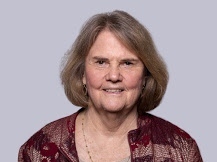 Diane Larsen-Freeman - 50th Anniversary NYS TESOL Conference Presenter (2020)
Diane Larsen-Freeman - 50th Anniversary NYS TESOL Conference Presenter (2020)
We asked NYS TESOL 2020 presenters to answer a few questions about the unique times we are living in. Here is what Diane Larsen-Freeman shared.
In what ways does your work support, celebrate, and validate multilingual learners’ cultural, racial, and linguistic assets?
My worldview and work are informed by complex dynamic systems theory (CDST). One of the defining features of a complex system is the regard for diversity. A complex system, such as that which exists in a classroom of multilingual speakers, has been shown to be much more robust due to its diversity. It is also more innovative.
In addition, a CDS perspective has challenged a traditional view of language as a static, bounded system. In CDST, language is a fluid resource that changes as it is adapted by its users to make meanings and to reflect their identities in different contexts. Therefore, the assets of multilingual learners become more visible in the dynamics of language and its use.
 Interview with a Tech-Savvy Teacher Matt Kolbusz
Interview with a Tech-Savvy Teacher Matt Kolbusz
Many of you listened to the webinar that Matt Kolbusz gave a few weeks ago for NYS TESOL. It was a great webinar and received a lot of excellent feedback, not least because Matt was so adept at demonstrating the use of Padlet and various other apps for the classroom. His demonstration made us all feel a little less nervous about trialing new educational technology in our classes. Matt teaches adult ESOL learners at the Queens Public library and has been using educational technology in his classes for a long time. This interest originates in his 'other' career in advertising technology. In Matt's own words: ed tech and ad tech are related. Ad tech typically blazes a trail that then informs and influences ed. tech.
Like every other teacher, Matt had to move his classes entirely online at the beginning of the COVID-19 crisis. It was not very difficult for him; he had already seen what opportunities educational technology could provide for teaching and learning. Therefore, my first question to him was: Why did you get into ed. tech?
When I started teaching, I realized that I was spending a lot of time doing mundane tasks: cutting paper strips, prepping materials - things that were not related to what the students wanted most, and that was feedback. Students want a personalized experience with their teachers and to obtain feedback quickly. This directly correlates with my ad tech experience. Typically, consumers want a customized experience. Advertisers need to know what the consumers' motivations are and, ultimately, what drives their world. Teachers also need to know their students' motivations and needs. Technology, such as electronic assessment tools, allows this to happen. I use technology as a tool to accelerate mundane tasks that we have to do and to provide the students with an environment that facilitates individuality and creativity.
Working Online with Fifth Graders
At the beginning of March, Tan Hynunh gave a webinar entitled The Fruits of Co-Teaching are Rooted in Intentional Co-Planning for NYS TESOL. At the time he was in his eighth week of being in lockdown in Vietnam and the same number of weeks teaching his fifth graders online. In New York, we were just coming to the realization that we would be teaching from home indefinitely. We thought it would be good to hear about his experience working online and what he has learned. Here are his thoughts:
Where do you work? Who do you teach?
I work as a fifth grade language specialist at a private international school in Vietnam. There are a hundred students in each grade of the elementary school. Prior to Vietnam, I taught in Laos, China, New Orleans, and Philadelphia, where I immigrated in 1986.

